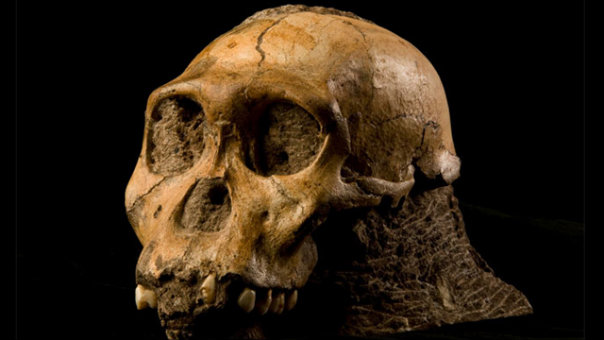
April 8, 2010
Malapa Man, the latest new member of the tangled branches that create the hominid family tree, was rolled out today, to meet the media. Have a look:

Photo by Brett Eloff courtesy of Lee Berger and the University of the Witwatersrand.
Charles Q. Choi at ScienceLive, Fox News, appears to have written one of the earliest comprehensive reports.
The cranium of the newly identified species, Australopithecus sediba, was found at the Malapa site, South Africa. As had previously leaked out, more than one specimen was found. It was confirmed to be a juvenile male and an adult female.
“Researchers stopped short of calling the new species, dubbed Australopithecus sediba, a missing link,” wrote Choi.
Australopithecus means ‘southern ape.’ Sediba means “natural spring, fountain or wellspring in Sotho, one of the 11 official languages of South Africa,” said researcher Lee Berger, a paleoanthropologist at the University of Witwatersrand in South Africa. This was “deemed an appropriate name for a species that might be the point from which the genus Homo arises,” Berger said.
Choi also got different opinions from various specialists.
As intriguing as the new fossil is, “it’s not everything the rumor mill said it was going to be,” said paleoanthropologist John Hawks at the University of Wisconsin at Madison. “It’s not a missing link.”
One of the biggest mysteries in human evolution is when the human genus Homo arose.
“What sets us apart most from the australopithecines is the size of our brain,” Hawks said. With this new fossil, “while it has a somewhat Homo-like face, it doesn’t have a Homo-like brain — it’s smaller than the average for the earlier [Australopithecus] africanus.”
“Maybe these findings suggest we look to South Africa for a possible origin for Homo, but there’s not a smoking gun here,” Hawks added. Intriguing fossils have also emerged in East Africa, and even Asia, and much remains unknown when it comes to Central Africa and West Africa. All these clues raise the question of which species were our ancestors and which just evolved similar traits in a parallel manner. “We just need to find more skulls,” he noted.
Once again, read Choi’s very long article here.
About Loren Coleman
Loren Coleman is one of the world’s leading cryptozoologists, some say “the” leading living cryptozoologist. Certainly, he is acknowledged as the current living American researcher and writer who has most popularized cryptozoology in the late 20th and early 21st centuries.
Starting his fieldwork and investigations in 1960, after traveling and trekking extensively in pursuit of cryptozoological mysteries, Coleman began writing to share his experiences in 1969. An honorary member of Ivan T. Sanderson’s Society for the Investigation of the Unexplained in the 1970s, Coleman has been bestowed with similar honorary memberships of the North Idaho College Cryptozoology Club in 1983, and in subsequent years, that of the British Columbia Scientific Cryptozoology Club, CryptoSafari International, and other international organizations. He was also a Life Member and Benefactor of the International Society of Cryptozoology (now-defunct).
Loren Coleman’s daily blog, as a member of the Cryptomundo Team, served as an ongoing avenue of communication for the ever-growing body of cryptozoo news from 2005 through 2013. He returned as an infrequent contributor beginning Halloween week of 2015.
Coleman is the founder in 2003, and current director of the International Cryptozoology Museum in Portland, Maine.
Filed under Breaking News, CryptoZoo News, Cryptozoology, Evidence, Extinct, Fossil Finds